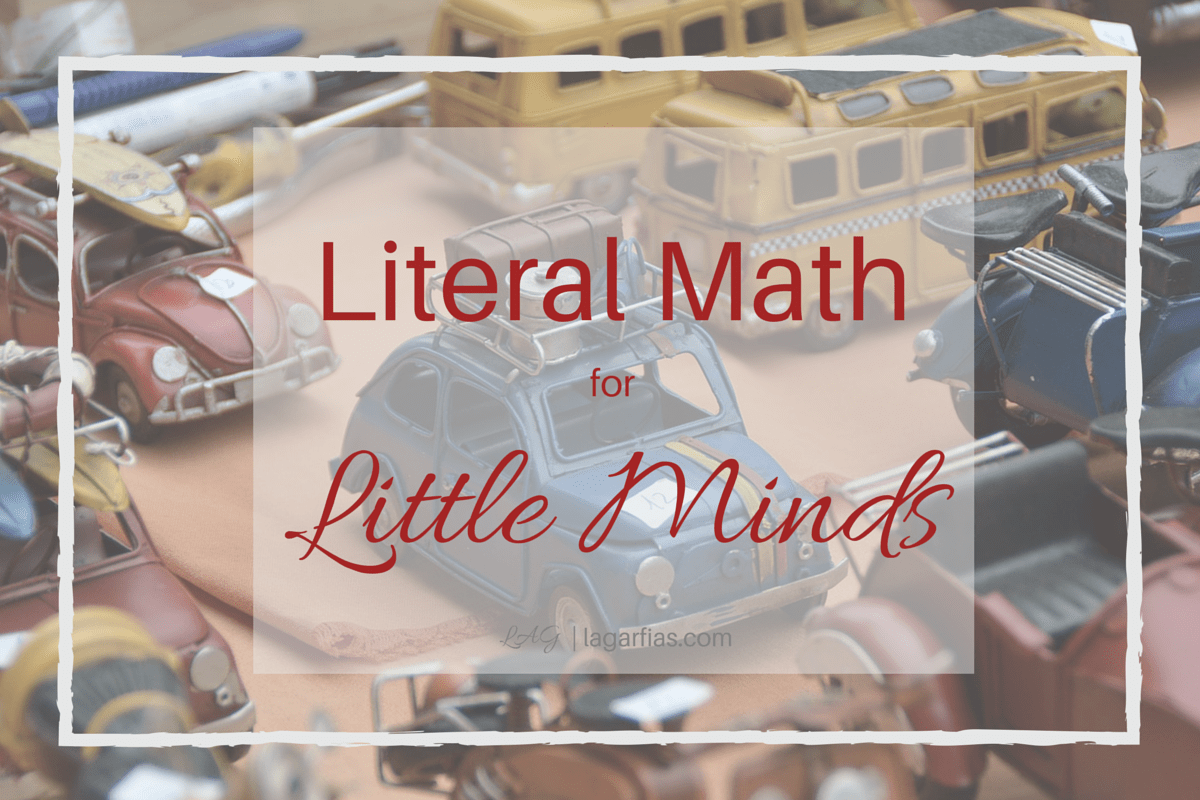
Math and Matchbox Cars
When my oldest son was a toddler, his favorite toys were matchbox cars. Everywhere  he went, be it doctors’ offices, friends’ homes, Sunday School, or to the relatives, he was ever on the lookout for a stash of toy vehicles. He always played with the cars in the same curious manner. Sprawled across the floor, he would carefully examine each one before placing them into parallel lines. After every single toy was in line, he would begin to run them, one by one, around the rug before putting the driven car or truck into a different row. I watched him play his odd game several times before attempting to join him; he immediately became frustrated with me.
he went, be it doctors’ offices, friends’ homes, Sunday School, or to the relatives, he was ever on the lookout for a stash of toy vehicles. He always played with the cars in the same curious manner. Sprawled across the floor, he would carefully examine each one before placing them into parallel lines. After every single toy was in line, he would begin to run them, one by one, around the rug before putting the driven car or truck into a different row. I watched him play his odd game several times before attempting to join him; he immediately became frustrated with me.
“No, Mommy!” he protested. “It doesn’t go there!” He took the red car, which I had placed beside another red car, and put it next to a blue truck.
“Are you sure?” I asked. I tried putting cars with like cars, colors with similar colors, and small vehicles with small vehicles, all to no avail. No sorting rule I tried would work. My small playmate grew increasingly frustrated with me until he finally asked me to find something else to do.
I never forgot his car game, and years later I asked my son if he also remembered it. His face immediately brightened at the memory, and he remarked at my failure to follow the rules.
“How were you sorting your cars?” I asked in desperation, leaning forward to hear the secret of his mind’s intricate working.
“By which car I wanted to buy next!” he declared. “I was playing a game like ‘Used Car Salesman,’ but I didn’t know how to explain that to you.” I heaved a sigh at the simplicity of his system.
Everyday life offers myriads of opportunities for young children to learn and explore mathematical principles in real-life situations. As we said in the last issue of Home School Enrichment, “The key for the home educator is to lay aside the workbooks and teach young ones the reality of math principles in their own environment.” How can a parent do this on a regular basis? [That earlier HSE article on teaching math was posted Monday.]
What is Literal Math?
First of all, we must understand what teaching math literally means to the young child. Children seven years old and younger think in concrete, not abstract, terms. A literal math education is the direct teaching of God’s order and patterns during the child’s daily life and the child’s application of those principles to his understanding of his domain.
The most important math principles for beginning literal math education are pattern recognition, time, space, shapes, and counting skills. When a young child is comfortable using and conversing about these math concepts, he is prepared to explore the mathematical sciences on a deeper level.
How Can I Teach Literal Math?
This begins with the simple daily patterns in the earliest years of the child’s life. A baby learns in the first weeks that God made day for wake and night for sleep. As the ebb and flo of life carries on, the baby will indicate his desire for meal, nap, and play activities as a result of Mommy’s skillful use of routines. By toddlerhood, the child begins to learn the names of breakfast, lunch, and dinner. He may anticipate a mealtime without being told, or even go to his bed at naptime when tired. This is more than merely vocabulary acquisition or even enjoyment of family mealtime. This is an important step in learning the concept of time.
Next, the child will begin to understand the broader rhythm of seasons. Around three years of age he may understand his birthday comes once in a long time and will reference major events to that all-important one. Soon after that, he may begin to pretend to tell time while looking at a clock; this is an excellent way to introduce numbers if the child wishes to know them.
The change of weather provides ample opportunity to teach the child of the breadth of time. Planting seeds and watching birds build nests in the spring; enjoying berries, bear feet, and growing plants in the heat of summer; autumn’s colors, the falling leaves, and cold weather clothing; and the celebration of all things snowy and Christmasy reinforce God’s principle that “to everything there is a season.” The child needs no worksheet or craft to tell him what each season means. He need only enjoy its works with his family to understand the import.
Around the time a child begins learning to read (or ages 5-7), you may draw your child’s attention to the regular patterns on the calendar. Introduce the days of the week, repeat them together, then count the numbers up to today’s date. Saying the months of the year up to the current month will familiarize your child with the order of the year. Within no time, the child will delight in informing the family what the date is every morning.
Work and play offer literal math lessons as well. Every chore in the house involves math principles to some extent. One of the first chores in our home is the emptying of small trash cans. To ensure every can has been emptied, the young child can count how many rooms have been visited.
Besides my first son’s unorthodox sorting of matchbox cars, there are many other uses of math in unsupervised preschool play. Young children divide their toy soldiers into two teams, they count pretend money for a store clerk, they cook food for a specified number of stuffed animal family members, they count out loud for hide-and-go-seek, they explore space and shapes with blocks and other building toys, and they divvy up available toys for siblings or playmates.
In order to clean up those toys, sorting skills are required. Blocks belong with blocks, not soldiers. Baby dolls belong with the dolls, not with plastic food. While sorting the toys, we sometimes say together, “Let all things be done decently and in order (I Cor. 14:40).”
Daily life provides ample opportunity to teach counting skills. From babyhood the child learns at bath time that many body parts come in pairs. When he is a little older, he can count by pairs all the shoes in Mommy’s closet – making him an expert in multiplying by 2 at a young age!
Snack time is a fun chance to count little things like cheerios, crackers, raisins, and berries. Soon the child understands the concept of subtraction – there one less each time he eats one! After that, it is a small step to learning to count backwards. Soon he will want to eat two at a time, counting and then subtracting by two. Later, Mommy will tell him that “mathematicians call this 5 minus 2 equals 3,” but not too soon. It is more important that the child understand how many cheerios he has if he is handed two more, or how many he has if he eats one. Math jargon can always wait until later.
Shopping time is another fun way to teach counting skills. My little ones love to “put six peaches in a bag for Mommy” or “choose two grapefruit.” They quickly learn that a dozen means 12 because there are 12 eggs in a dozen and 12 bagels in a dozen — so then how many are there if we eat half of them? We may need to fry up some eggs and toast some bagels for breakfast to find out!
Play money is fun to count, but real money is even more fun! When they begin getting a little allowance, I require my little ones to count out the change aloud to me before I will let them put the coins in their wallets. We cannot be responsible for what we do not understand. Once, I got to keep a nickel of my daughter’s because she counted it as “twenty-five cents!” Everyone is highly motivated now to remember that a nickel is five cents.
Outdoor exploration is important to the young mathematician. He learns to conceptualize large and small spaces as he moves around the yard or playground unencumbered. He observes how shapes seem to change as they move through space when he throws, kicks, rolls, or slides them. He feels the difference speed and gravity make on his own body. His viewpoints from bumping into a playmate, swinging high on the swing set, and hanging upside-down on the monkey-bars are all filed away in his mind for later work in geometry and physics. Like Einstein’s think experiments and the Wright Brothers’ dreams that changed history, your child’s imaginations fuel his desire to find the patterns that make the world work.
Many parents feel they must purchase the latest in early math education curriculum to give their child a leg up on understanding the basic principles. On the contrary, the young mind will retain and understand far better when allowed to explore and delight in the wonders of God’s created order. Immerse your child in the wonder of God’s patterns, and he will delight in applying them to his daily life.
First published in Home School Enrichment Nov/Dec 2010.


So that’s why my son does that! Lol, since we started using his toy cars as counters for math time he has really developed an interest in math. I wish this post was available a year ago, it would have saved me a lot of money buying manipulatives that he doesn’t care less about!
Our manipulatives have become army men and doll food. I can’t find half of any set. The only ones we really miss are tangrams; those are fun, so I keep buying more.
We also use candies like gumballs. That always makes it more exciting!
My son was/is obsessed with trains. We use trains a lot in writing, but not so much in math.
Love this post! In addition to all of the other benefits of teaching math this way, you won’t ever hear, “But why do I need to learn math? We don’t ever use it!”
Exactly! Math should be the most practical subject we study. Around here, I get, “Why do we have to study grammer?” Lol!